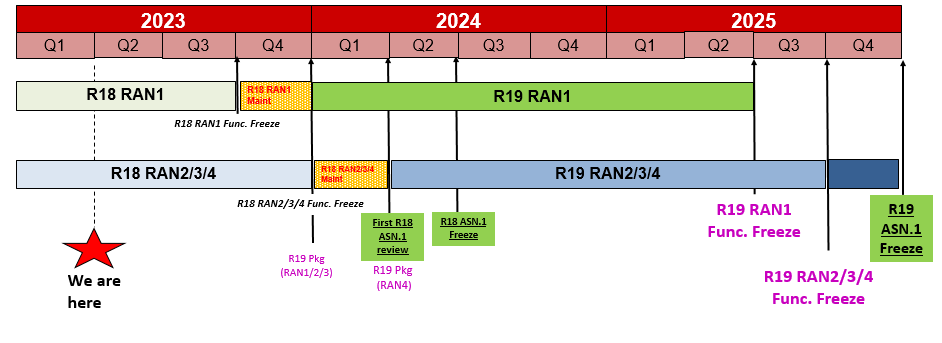
Summary Report from 3GPP plenaries (mainly RAN) #99 (Rotterdam, the Netherlands, 20 - 24 March 2023)
Summary Report from 3GPP plenaries (mainly RAN) #99 (Rotterdam, the Netherlands, 20 - 24 March 2023)
Hans van der Veen, NEC Laboratories Europe GmbH
General
Rel-17
- The remaining Rel-17 RAN4 performance work was completed.
Rel-18
- No new Rel-18 work was allowed in RAN, except following request from SA2, ITU-R and to resolve open issues:
- IMT-2020 satellite submission
- RAN3 NPN, slicing and URLLC (based on SA2 needs)
- BandWidth Part without restriction
- Enhanced LTE Support for UAV
- No upscoping of existing Rel-18 work was allowed in RAN
Rel-19
- Rel-19 timeline was decided (18 months release until December 2025)
RAN Meeting planning (Endorsed: RP-230050)
No change was made to the RAN Rel-18 timeline. Rel-19 was decided to be an 18-month release, with the ASN.1 completing in December 2025. It had already been decided prior to the meeting that the Rel-19 Workshop will be 15-16 June in Taipei, Taiwan. Because a significant number of companies in SA wants a longer release (by three months), it was agreed that if SA finds something that is commercially highly significant and cannot be done in the planned timeline, this decision will be revisited.

3GPP submission to IMT-2020 Satellite (New SI: RP-230736; LSout: RP-230771; RP-230772)
RAN decided to submit NR-NTN and NTN IoT (NB-IoT/eMTC) for inclusion in the new ITU-R Recommendation on IMT-2020 Satellite and approved a new SI to carry out the self-evaluation process and submit its results to ITU-R by the indicated deadline.
Rel-17
Rel-17 Planning and progress (RAN4 performance work completed)
Stage 1: frozen December 2019 with exceptions; Stage 1 work completed by June 2020
RAN work package: approved December 2019
Stage 2: frozen June 2021 with exceptions; Stage 2 work completed by June 2022.
RAN1: frozen December 2021
RAN2/3/4 core functionality: frozen March 2022 with exceptions; RAN2/3/4 core work completed by September 2022.
Stage 3: frozen March 2022 with exceptions; Stage 3 work completed by September 2022.
ASN.1 and open APIs: frozen June 2022. September 2022 version is recommended for implementation.
RAN4: All performance WIs completed by March 2023.
Closed Rel-17 Work Items and Study Items (excluding spectrum-related and conformance testing)
Rel-17 NR
- Perf.: Extending current NR operation to 71GHz
- Perf.: Solutions for NR to support non-terrestrial networks (NTN)
Rel-17 SA Work Item Summaries (descriptions of features in the release after the work has actually finished)
- <None>
Rel-18
Rel-18 Planning and progress (No changes)
Stage 1: frozen December 2021 without exceptions
RAN1/2/3 work package: approved December 2021
RAN4 work package: approved March 2022
Stage 2: freezing target June 2023
RAN1: freezing target September 2023
RAN2/3/4 core functionality: freezing target December 2023
Stage 3: freezing target March 2024
ASN.1 and open APIs: freezing target June 2024 (review date March 2024)
RAN4: freezing target June 2024
Closed Rel-18 Work Items and Study Items (excluding spectrum-related and conformance testing)
Rel-18 NR
- SI: Study on UE support of regionally-defined subsets of an NR band
- SI: Study on efficient utilization of licensed spectrum that is not aligned with existing NR channel bandwidths
- SI: Study on XR Enhancements for NR
- SI: Study on enhancement for 700/800/900MHz band combinations for NR
Rel-18 LTE
- Core: Maximum Power Reduction Requirements (MPR) for LTE intra-band Carrier Aggregation (CA) with a Component Carrier (CC) gap larger than 35 MHz
Rel-18 RAN Work Item Summaries (descriptions of features in the release after the work has actually finished)
- RP-230793 WI Summary: Maximum Power Reduction Requirements (MPR) for LTE intra-band Carrier Aggregation (CA) with a Component Carrier (CC) gap larger than 35 MHz
Rel-18 SA Work Item Summaries (descriptions of features in the release after the work has actually finished)
- <None>
Rel-18 NR: Ambient IoT (Summary: RP-230801; Approved pCRs: RP-230571, RP-230803, RP-230807, RP-230808)
The pCRs implement decisions and agreements from RAN#98e and RAN#99: (1) Representative use cases (RP-230803);
(2) Topologies (RP-230807); (3) Deployment scenarios, connectivity topologies and RAN design targets (RP-230808).
Rel-18 NR: Sidelink evolution (Revised WI: RP-230077)
The CA objective was kept in the Rel-18 WI, with the understanding it mainly targets some V2X use cases. RAN1 is tasked to support only 15 and 30 kHz SCSs for dynamic resource pool sharing. Frequency band combinations are limited to band n47 (ITS-dedicated spectrum).
Rel-18 NR: Enhanced support of reduced capability NR devices (Endorsed WF: RP-230778)
Rel-18 eRedCap UE capable of 20MHz + PR1 and Rel-18 eRedCap UE capable of BW3/PR3 + PR1 are designed/targeted to same peak data rate, i.e., 10Mbps
Rel-18 NR: Expanded and Improved NR Positioning (Revised WI: RP-230328)
RRM measurements with measurement gaps were added to the objective.
Rel-18 NR: Support for UAV (Uncrewed Aerial Vehicles) (Revised WI: RP-230782)
The objective was changed to specify support for UAV identification broadcast in NR PC5 only.
Rel-18 NR: NTN (Non-Terrestrial Networks) enhancements (Revised WI: RP-230809)
The objective was changed to remove the discussion on power flux density. Coverage enhancements remain part of the WI but the proposed additional DL coverage enhancements were not agreed.
Rel-18 NR: XR (eXtended Reality) enhancements for NR (Revised WI: RP-230786)
The objective was changed to remove the provision of XR traffic assistance information for DL and UL and to provide detailed objectives for enhancements for XR awareness. For 2Rx XR devices, the following way forward was endorsed:
Step-1: Recognize that form factor limitations of a subset of XR devices can make it impossible for these devices to support 4 antenna ports. Exact characterization and form factor limitations of these devices are to be studied in RAN plenary. Contributions are invited to TSG-RAN#100 to address this.
Step-2: Contingent on the outcome of the Step-1: Recognize the importance of identifying these devices in the network, and potential network impact (e.g. performance, coverage, capacity) and UE impact
Rel-18 NR: NR support for dedicated spectrum less than 5MHz for FR1 (Revised WI: RP-230186)
Bands n106 and n85 were added to the objective.
Approved Rel-18 Work Items and Study Items (excluding spectrum-related and conformance testing)
- RP-230736 SI: Study on Self-Evaluation towards IMT-2020 Satellite Radio Interface Submission
Keywords: Provide description of self-evaluation results towards IMT-2020 submission to ITU-R WP 4B against technical performance requirements defined by Report ITU-R M.2514. The candidate IMT-2020 RIT/SRIT(s) submission by 3GPP based on Rel-17 NTN (including both NR NTN and IoT NTN), will be evaluated and described as part of the study.
- RP-230788 WI: Further Enhancement of Private Network Support for NG-RAN
Keywords: Support 5GS functions of SA2 Enhanced support of Non-Public Networks Phase 2: (1) Support for enhanced mobility by enabling support for idle and connected mode mobility between SNPNs without new network selection; (2) Support for non-3GPP access for SNPNE.
- RP-230787 WI: Further enhancement of RAN Slicing for NR
Keywords: (1)Evaluate impact, if any, on RAN to support Network Slice Service continuity scenario; (2) Evaluate impact, and specify solution, if needed, to support Partially Allowed NSSAI in RRC_Connected Mode.
- RP-230754 WI: NR Timing Resiliency and URLLC enhancements
Keywords: (1) 5GS network timing synchronization status and reporting; (2) Interworking with TSN network deployed in the transport network; (3) Adapting downstream and upstream scheduling based on RAN feedback for low latency communication.
- RP-230805 WI: BWP without restriction for NR
Keywords: (1) For Option A: Study and specify if any clarifications of the existing requirements are needed, e.g., applicability of requirements, conditions of gap configuration etc.; (2) For Option B-1-1: Specify support of BM/RLM/BFD based on SSB outside the active BWP without interruptions; (3) For Option C: Specify support of BM/RLM/BFD based on NCD-SSB within active BWP for non-RedCap UEs; (4) For Option B-1-2: Specify support of BM/RLM/BFD based on SSB outside the active BWP with interruptions with conditions;
The expected RAN2 impacts are RRC configuration signalling for the above options, and capability signalling aspects.
- RP-230783 WI: Enhanced LTE Support for UAV
Keywords: (1) Specify support for UAV identification broadcast (BRID) in LTE PC5; (2) Specify necessary UE types and additional OOBE requirements for aerial UEs in 1710-1785 MHz, 2500-2570 MHz and 2570-2620 MHz.
Rel-19
Rel-19 Planning (Workshop dates fixed; Stage 2, Stage 3, RAN and ASN.1/open APIs planning)
RAN Workshop: June 2023
SA Workshop: June 2023
Stage 1: freeze December 2023 (80% normative work by September 2023)
SA Stage 2 work package: complete package planned to be approved December 2023 (1st part (SA/CT) by September 2023)
RAN1/2/3 work package: planned to be approved December 2023
RAN4 work package: planned to be approved March 2024
Stage 2: freezing target December 2024
RAN1: freezing target June 2025
RAN2/3/4 core functionality: freezing target September 2025
Stage 3: freezing target December 2025
ASN.1 and open APIs: freezing target December 2025
RAN4: freezing target December 2025



